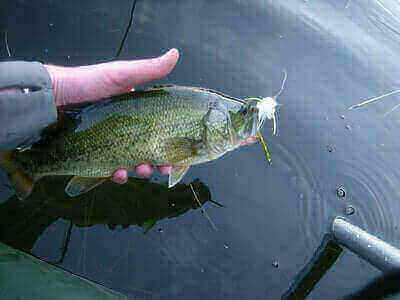Disclosure: We may earn commissions if you purchase products after clicking on a link from our site.
Do you want to learn how to catch largemouth bass? The largemouth bass is one of the most exciting gamefish in the world. They are found in the central and eastern United States as well as northern Mexico. They are a favorite of anglers as they strike aggressively, fight hard, and usually leap out of the water in a display of acrobatics. In this article, we will discuss how to catch largemouth bass, fishing techniques to use, baits, lures, and equipment needed to go largemouth bass fishing.
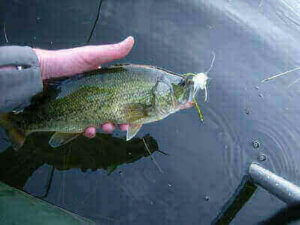
Table of Contents
- 1 How To Catch Largemouth Bass
- 2 Largemouth Bass Tackle
- 3 How To Catch Largemouth Bass From Shore
- 4 How To Catch Largemouth Bass in Summer
- 5 How To Catch Largemouth Bass in a Lake
- 6 How To Catch Largemouth Bass At Night
- 7 How To Catch Largemouth Bass In A Pond
- 8 Best Bait For Largemouth Bass
- 9 Best Largemouth Bass Lures
- 10 Largemouth Bass Fishing Tips
- 11 The Bottom Line
How To Catch Largemouth Bass
1. Baitcasting
Baitcasting is a popular fishing method used by anglers to target largemouth bass, renowned for its accuracy and control when casting lures into tight spaces, such as around submerged structures or vegetation where bass often hide.
This technique involves using a baitcasting reel, which sits atop the fishing rod and requires a thumb-controlled spool for casting. The baitcasting reel allows for precise lure placement and enables anglers to manipulate lures with greater finesse, making it ideal for presenting lures like jigs, crankbaits, or soft plastics in specific areas where largemouth bass are likely to be lurking.
Properly mastering the art of baitcasting requires practice and patience to avoid backlash or bird’s nests, but once mastered, it offers unparalleled accuracy and control. To learn more about baitcasting techniques and best practices for catching largemouth bass, visit the website of the U.S. Fish and Wildlife Service.
2. Fly Fishing
Fly fishing for largemouth bass is a thrilling and rewarding angling method that offers anglers a unique and immersive experience on the water. Unlike conventional spin or baitcasting gear, fly fishing employs lightweight rods, specialized lines, and hand-tied flies to entice bass into striking.
With fly fishing, anglers use the weight of the fly line to deliver lightweight artificial flies delicately and accurately to specific locations where largemouth bass are likely to be found, such as along the edges of weed beds, under overhanging vegetation, or near structures.
This method requires patience, precision, and finesse, as anglers must mimic the natural movements of prey to trigger a bass’s predatory instincts. Successful fly fishing for largemouth bass often involves mastering various casting techniques, including roll casts, overhead casts, and accurate presentations to entice strikes.
Fly fishing for largemouth bass provides anglers with a challenging yet deeply rewarding angling experience that connects them with nature and the thrill of pursuing these elusive freshwater predators.
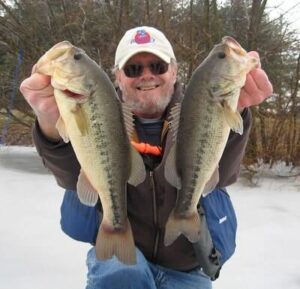
3. Bottom Fishing
Bottom fishing for largemouth bass involves presenting bait or lures near the lake or riverbed where bass often forage for food. Anglers typically use various types of bait, such as live baitfish, nightcrawlers, or artificial lures like jigs or soft plastics, rigged on weighted hooks to reach the bottom effectively.
This method can be particularly effective when targeting bass in deeper water or during periods when they are holding close to submerged structures, such as fallen trees, rock piles, or drop-offs. Anglers may employ different bottom fishing techniques, including Carolina rigs, Texas rigs, or drop shot rigs, to effectively present the bait or lure near the bottom and entice strikes from lurking bass.
Patience and attention to detail are essential when bottom fishing for largemouth bass, as anglers must carefully monitor their bait’s movement and adjust their presentation to match the bass’s feeding behavior and preferences.
4. Trolling
Trolling is a versatile fishing method used to target largemouth bass, particularly in larger bodies of water such as lakes and reservoirs. Anglers typically use a boat equipped with one or more fishing rods trailing lures or bait behind it while moving at a slow to moderate speed.
The key to successful trolling for largemouth bass is covering a large area of water to locate actively feeding fish. Anglers can vary the trolling speed, depth, and the type of lure or bait used to target bass at different depths and locations within the water column.
Common trolling setups for largemouth bass include using diving plugs, crankbaits, or swimbaits to imitate the movement of baitfish or other prey species. Additionally, anglers may employ downriggers or planer boards to vary the depth at which their lures are presented, allowing them to effectively target bass holding at different depths.
Trolling for largemouth bass can be a productive and enjoyable fishing method, offering anglers the opportunity to cover large areas of water and locate actively feeding fish.
Largemouth Bass Tackle
There are many options for the largemouth bass tackle. The equipment you settle on will depend on the technique you use to fish for bass. A medium-action casting setup will work for most bass fishing methods. However, you can opt for a heavy baitcasting rod with a 50lb braid with a 30lb leader to fish heavy trout imitation swimbaits or a light spinning rod with 4lb test to fish small drop-shot plastics.
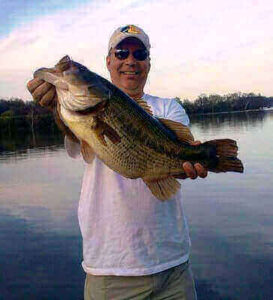
How To Catch Largemouth Bass From Shore
When fishing for bass from the shore, look for structures that they may be hiding in to ambush their prey. Docks, rocks, weeds, and bridge pilings are some of the structures to target when fishing from the shore. Drop your line around those structures to get bites and catch bass.
How To Catch Largemouth Bass in Summer
During the summer, bass will move to deeper water in search of cooler water. Look for weeds that bass will use as cover to use as shade from the sunlight and also ambush their prey. Look for spots where the weeds make a wall or create an edge. Bass will be found there seeking cover. Use crankbaits or jigs to fish for them.
How To Catch Largemouth Bass in a Lake
When fishing bass in lakes, look for structures like underwater humps, rock or wood pilings, and channels. You will most likely find bass around these structures. Use soft plastics like Carolina-rigged worms can be used to get bites.
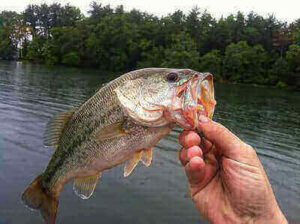
How To Catch Largemouth Bass At Night
When fishing for largemouth bass at night, look for transitions where there is deep water close to the shore. Largemouth bass will move through these transitions to find baitfish. Additionally, drop-offs, points, channel bends, and ditches are areas that you should target when fishing for largemouth bass during the night.
Use loud lures like topwater lures, spinnerbaits, lipless crankbaits, and buzz baits. At night, you need to get the attention of the bass and these loud lures will make a noise to attract them. Adding scent to your lures and using baits that make sounds like crawfish will do the trick.
Full moon is a good time to fish at night whether it is for largemouth bass or other species of fish. Why? Because with a full moon, the fish can see much better in the water than baitfish. Even humans can see better at night when there is a full moon. Casting and jigging are fishing methods often used to catch largemouth bass at night.
How To Catch Largemouth Bass In A Pond
When fishing for largemouth bass in a pond, look for points, corners, logs, fallen trees, rocks, water drains, culverts, etc. Points along the shoreline will usually hold largemouth bass. Largemouth bass will always find a structure that they can use as cover to ambush their prey.
Points work well as cover for largemouth bass and when you find points in a pond, target that area for largemouth bass. Additionally, largemouth bass also use corners as perfect areas to sit and ambush their prey.
Shad, minnows, crappie, and small bullhead catfish are some of the bait for largemouth bass. Lures also work when fishing for largemouth bass in a pond.
The Texas rig worm, topwater frog, and chatter baits are some of the lures that work well when fishing for largemouth bass in a pond. Baitcasting, fly fishing, bottom fishing, and jigging are fishing methods used when fishing for largemouth bass in a pond.
Best Bait For Largemouth Bass
1. Shad
Using shad as bait for catching largemouth bass can be highly effective, especially in areas where shad are abundant and natural prey for bass. Live shad can be rigged on hooks using various methods, such as freelining or using a slip bobber rig, allowing them to swim naturally and entice bass with their natural movement.
Alternatively, anglers can use shad imitations such as soft plastic swimbaits or crankbaits designed to mimic the size, shape, and swimming action of shad. These artificial lures can be retrieved at various speeds and depths to match the bass’s feeding preferences and the prevailing fishing conditions.
Whether using live shad or shad imitations, presenting these baits near covers such as submerged vegetation, rocky structures, or drop-offs where bass are likely to ambush prey can increase the chances of success. Overall, using shad as bait for largemouth bass fishing can be a reliable tactic for enticing strikes from these voracious predators.
2. Yellow Perch
Using yellow perch as bait for catching largemouth bass can be a fruitful strategy, particularly in waters where yellow perch are prevalent and serve as natural forage for bass. Anglers can employ both live and dead yellow perch as bait, depending on their availability and fishing preferences.
Live yellow perch can be rigged on hooks using techniques such as Carolina rigs or drop shot rigs, allowing them to swim freely and attract bass with their natural movements. Alternatively, dead yellow perch can be cut into chunks or fillets and used as cut bait, providing a scent trail that can entice bass to strike.
Additionally, anglers can utilize yellow perch imitations such as soft plastic swimbaits or crankbaits to mimic the appearance and swimming action of these forage fish. When presenting yellow perch as bait, targeting areas with submerged structure, vegetation, or drop-offs where bass are likely to congregate and feed can increase the likelihood of success.
Overall, using yellow perch as bait for largemouth bass fishing can be an effective tactic for enticing strikes and landing trophy-sized bass.
3. Sunfish
Using sunfish as bait for catching largemouth bass can be highly effective, as sunfish are a natural prey species for bass and are often abundant in the same habitats. Live sunfish, such as bluegill or pumpkinseed, can be rigged on hooks using various methods, including Carolina rigs, Texas rigs, or under a slip bobber, allowing them to swim freely and attract bass with their natural movements.
Dead sunfish can also be used as cut bait, providing a scent trail that can lure bass to the area. Additionally, anglers can use sunfish imitations such as soft plastic lures or crankbaits to mimic the appearance and behavior of these forage fish.
When presenting sunfish as bait, targeting areas with submerged structures, weed beds, or drop-offs where bass are likely to be hunting can increase the chances of success. Overall, using sunfish as bait for largemouth bass fishing can be a productive tactic for enticing strikes and landing quality fish.
4. Shiners
Using shiners as bait for catching largemouth bass is a popular and effective strategy among anglers. Shiners, particularly golden shiners, are a natural prey item for bass and can be rigged in various ways to entice strikes. They can be fished live on a hook using a slip bobber or free-lined to allow them to swim naturally in the water, enticing bass with their realistic movements.
Additionally, anglers can use shiner imitations such as soft plastic lures or crankbaits to mimic the appearance and behavior of live shiners. When targeting largemouth bass with shiners, it’s essential to present them near cover or structures where bass are likely to be hiding, such as submerged vegetation, fallen trees, or rocky outcrops.
Overall, using shiners as bait for largemouth bass fishing can be highly effective in enticing strikes and landing trophy-sized fish.
5. Catfish
Using catfish as bait for catching largemouth bass is not a common practice due to several reasons. While catfish can be an abundant and easy-to-catch bait option, they are typically larger and less agile than other baitfish commonly used for bass fishing, such as shad or minnows.
Additionally, catfish tend to have a stronger odor, which may not be as appealing to largemouth bass compared to other bait options. Moreover, using catfish as bait may raise ethical concerns among anglers, as it involves sacrificing a live fish to attract another species.
Overall, while catfish can theoretically be used as bait for largemouth bass, anglers generally prefer more traditional bait options that are better suited for enticing strikes from bass.
6. Trout
Using trout as bait for catching largemouth bass can be effective in certain situations, especially in regions where trout are abundant and legal to use as bait. Trout are known for their lively swimming action and natural appearance, which can attract predatory bass.
Anglers often use smaller trout as live bait, either rigged on a hook or suspended under a float, to entice strikes from largemouth bass. Additionally, trout can be used as cut bait or chunk bait, where sections of the fish are used to create scent trails and attract bass to the fishing area.
However, it’s essential to check local fishing regulations, as using trout as bait may be restricted or prohibited in some areas to prevent the spread of diseases or protect native fish populations. Additionally, anglers should consider ethical considerations when using live fish as bait and ensure they are following all laws and regulations regarding bait use and fish handling.
7. Walleye
Using walleye as bait for catching largemouth bass can be an unconventional but effective strategy, especially in waters where both species coexist. Walleye, known for their firm flesh and strong scent, can attract the attention of predatory bass, particularly during low light conditions or when bass are feeding opportunistically.
Anglers often use cut or chunk bait from smaller walleye to create scent trails and entice strikes from bass, especially in areas where walleye are abundant and legal to use as bait. However, it’s crucial to check local fishing regulations as using walleye as bait may be restricted or prohibited in some regions to conserve walleye populations. Additionally, anglers should ensure ethical practices and handle live bait responsibly to minimize stress and harm to the fish.
8. Minnows
Using minnows as bait for catching largemouth bass is a classic and effective technique favored by many anglers. Live minnows, such as shiners or fathead minnows, are versatile baits that can be fished in various ways, including under a bobber, on a jighead, or rigged seedless.
Their natural swimming action and appealing scent make them irresistible to bass, particularly in clear or lightly stained water where their silhouette and movement can mimic natural prey. Anglers often target submerged structures, such as weed beds, fallen trees, or rocky areas, where bass tend to ambush their prey.
When using minnows as bait, it’s essential to keep them lively and healthy, ensuring they exhibit a natural swimming behavior to maximize their effectiveness in attracting strikes from largemouth bass.
9. Crayfish
Using crayfish as bait for catching largemouth bass is a popular and productive method, especially in areas where crayfish are abundant. Largemouth bass are known to feed on crayfish due to their high protein content and natural availability in many freshwater habitats.
Anglers often rig live crayfish on a hook with a weight to keep them near the bottom, where bass tend to forage for food. Additionally, artificial crayfish lures, such as soft plastics or hard-bodied imitations, can be used to mimic the appearance and movement of real crayfish.
These lures can be retrieved slowly along the bottom or worked around the structure to entice strikes from bass. Crayfish are particularly effective bait during the spring and summer months when bass are actively feeding and seeking out protein-rich meals to support their growth and energy needs. Overall, using crayfish as bait can be a productive strategy for targeting largemouth bass in various freshwater environments.
10. Bluegill
Using bluegill as bait for catching largemouth bass can be highly effective, as largemouth bass are known predators of smaller fish species like bluegill. Anglers often target larger bass by presenting live bluegill on a hook or using them as cut bait to entice strikes.
Bluegill can be rigged with weights to keep them at the desired depth or allowed to swim freely near cover where bass may be lurking. Additionally, artificial lures designed to mimic bluegills, such as swimbaits or crankbaits, can be used to imitate the natural movement and appearance of these prey fish.
When using live bluegill as bait, anglers should consider local regulations regarding the use of live bait and ensure that the bluegill is ethically and legally obtained. Overall, bluegill can be a valuable bait option for anglers targeting largemouth bass in various freshwater habitats, especially in areas where bluegill populations are abundant.
11. Nightcrawlers
Nightcrawlers, also known as earthworms, are a popular and versatile bait option for anglers targeting largemouth bass. These large, juicy worms are readily available at bait shops or can be collected from damp soil after rain.
When rigged on a hook, nightcrawlers emit natural scents and wriggling movements that attract bass. Anglers often fish nightcrawlers below a bobber or on a Carolina rig to keep them near the bottom where bass frequently feed.
Alternatively, they can be threaded onto a weedless hook and cast near cover or structure where bass are likely to hide. The natural presentation of nightcrawlers appeals to the predatory instincts of largemouth bass, making them effective bait for anglers of all skill levels. Additionally, nightcrawlers are affordable and easy to use, making them a go-to choice for many bass anglers.

Best Largemouth Bass Lures
1. Jigs
Jigs are versatile lures widely used by anglers to target largemouth bass in various fishing conditions. These compact, weighted lures consist of a lead head with a hook molded into it, often adorned with a skirt made of silicone or rubber strands that mimic the appearance of baitfish or crawfish.
Anglers can customize jigs by selecting different colors, sizes, and trailer options to match the prevailing forage and water conditions. When fishing with jigs, anglers typically employ a casting or flipping technique, allowing the jig to sink to the desired depth before imparting lifelike movements by twitching or dragging it along the bottom.
Jigs excel at enticing bass lurking in submerged vegetation, brush piles, rocky structures, or other cover where bass tend to ambush prey. Their weedless design allows anglers to penetrate dense cover with minimal snagging, making them an effective choice for enticing strikes from wary largemouth bass. Whether fished solo or in combination with trailers like plastic craws or creature baits, jigs offer anglers a versatile and reliable option for targeting trophy-sized largemouth bass in a variety of freshwater habitats.
2. Crankbaits
Crankbaits are popular lures among anglers targeting largemouth bass due to their versatility and effectiveness in covering water quickly. These hard-bodied lures typically feature a diving lip that causes them to dive to specific depths when retrieved, allowing anglers to target bass at various depths in the water column.
Crankbaits come in a range of shapes, sizes, and diving depths, making them suitable for fishing in different environments, from shallow flats to deep drop-offs. Anglers can choose between shallow-running crankbaits for targeting bass in shallow water or deep-diving models for probing deeper structures.
When fishing with crankbaits, anglers often use a steady retrieve or employ a stop-and-go retrieve to mimic the erratic movements of injured baitfish, enticing bass to strike. Additionally, crankbaits are effective at triggering reaction strikes from aggressive bass, making them ideal for covering large areas of water and locating actively feeding fish.
Whether cast, trolled, or retrieved along the bottom, crankbaits remain a go-to lure for bass anglers looking to entice strikes from largemouth bass in a variety of freshwater habitats.
3. Jerkbaits
Jerkbaits are a versatile and effective lure choice for targeting largemouth bass, especially in cooler water temperatures or during periods of low activity. These long, slender lures typically feature a lifelike appearance and are designed to imitate injured baitfish, making them irresistible to hungry bass.
Anglers can employ a variety of retrieval techniques with jerkbaits, including sharp twitches followed by pauses to mimic the erratic movements of wounded prey. This action can trigger aggressive strikes from nearby bass, particularly in clear water where fish have a clear view of the lure’s action.
Jerkbaits can be fished at various depths depending on their buoyancy and design, allowing anglers to effectively target bass holding in different parts of the water column. Whether retrieved slowly near the surface or worked methodically along the bottom, jerkbaits excel at enticing strikes from largemouth bass in a wide range of freshwater environments. Their lifelike appearance, enticing action, and ability to provoke reaction strikes make them a valuable addition to any angler’s tackle box when targeting trophy-sized bass.
4. Rubber Worms
Rubber worms, also known as plastic worms or soft plastic worms, are a tried-and-true lure option for anglers targeting largemouth bass. These artificial baits come in a variety of lengths, colors, and designs, allowing anglers to match the hatch or experiment with different presentations to entice strikes.
One of the key advantages of rubber worms is their lifelike appearance and action in the water. When rigged properly on a hook, these soft baits mimic the movement of live prey, such as worms or small baitfish, which can trigger a predatory response from bass.
Anglers typically fish rubber worms using a technique called “Texas rigging” or “Carolina rigging,” where the worm is rigged weedless to minimize snagging and presented near cover or structure where bass are likely to be hiding. Slowly dragging or hopping the worm along the bottom can simulate natural foraging behavior and tempt bass into striking.
Additionally, rubber worms can be rigged weightless and twitched across the water’s surface, mimicking the action of a wounded baitfish and enticing aggressive surface strikes from hungry bass. With their versatility, realism, and proven effectiveness, rubber worms remain a staple lure for anglers pursuing largemouth bass in various freshwater habitats.
5. Spinnerbaits
Spinnerbaits are highly effective lures for targeting largemouth bass in a variety of fishing conditions. Comprising a safety pin-shaped wire with a spinning blade or blades attached, spinnerbaits create flash and vibration underwater, mimicking the appearance of a fleeing baitfish.
This action triggers the predatory instincts of bass, enticing them to strike. One of the advantages of spinnerbaits is their versatility; they can be fished at different depths, speeds, and around various types of cover, making them suitable for both shallow and deep-water fishing.
Anglers often use spinnerbaits to cover a lot of water quickly, casting them along weed edges, submerged brush, rocky structures, or other potential bass hideouts. Retrieving the spinnerbait at a steady pace or employing a stop-and-go retrieve can imitate the erratic movement of injured prey, increasing the lure’s appeal to bass.
Spinnerbaits are available in a range of sizes, colors, and blade configurations, allowing anglers to tailor their presentation to match prevailing conditions and the bass’s preferences. Whether fishing in murky water, low light conditions, or clear water, spinnerbaits can be an effective choice for enticing strikes from largemouth bass.
6. Swimbaits
Swimbaits are a popular and effective lure choice for targeting largemouth bass, especially for anglers seeking trophy-sized fish. These lifelike lures mimic the appearance and swimming action of various baitfish, making them irresistible to bass.
Available in a variety of sizes, shapes, and colors, swimbaits can be rigged with single or multiple hooks, allowing anglers to match the hatch and target bass at different depths and in various conditions. Swimbait fishing requires a steady retrieve, with occasional pauses or twitches to mimic the movement of injured or fleeing prey.
Anglers often use swimbaits to cover expansive areas of water, casting them along weed lines, points, drop-offs, and other structures where bass are likely to ambush their prey. Whether retrieved slowly near the bottom or retrieved steadily through open water, swimbaits can entice aggressive strikes from largemouth bass, making them a versatile and productive lure choice for bass anglers of all skill levels.
7. Topwater Lures
Topwater lures are a thrilling and effective choice for targeting largemouth bass, especially during low-light conditions or when bass are feeding near the surface. These lures, designed to create surface disturbance and mimic wounded or struggling prey, can provoke explosive strikes from aggressive bass.
Anglers often use a variety of topwater lures such as poppers, buzz baits, and walking baits to imitate different types of prey and trigger bass into striking. The key to success with topwater lures is to create enticing action on the surface by twitching, popping, or retrieving the lure in a way that mimics the behavior of natural prey.
Topwater fishing is highly visual and exciting, as anglers witness the electrifying strikes as bass explodes from beneath the surface to attack the lure. This technique is particularly effective in areas with submerged vegetation, along the edges of lily pads, or near other covers where bass lurk in wait for unsuspecting prey. Whether fished at dawn, dusk, or under the cover of darkness, topwater lures offer anglers an exhilarating way to target largemouth bass and create unforgettable fishing experiences on the water.
8. Weedless Jigs
Weedless jigs are a versatile and effective lure option for targeting largemouth bass, especially in areas with dense vegetation, submerged brush, or rocky cover where traditional lures might get snagged. These jigs feature a streamlined design with a single hook positioned close to the head of the bait, allowing them to slip through vegetation and cover without getting caught.
Anglers often rig weedless jigs with soft plastic trailers such as crawfish imitations, creature baits, or swimbaits to create a lifelike presentation that entices bass hiding in heavy cover. The weedless design of these jigs enables anglers to penetrate thick vegetation and explore otherwise inaccessible areas where bass seek refuge and ambush prey.
By pitching or flipping weedless jigs into pockets of cover or along the edges of submerged structures, anglers can effectively target largemouth bass and trigger strikes from wary fish. Weedless jigs are particularly effective when fished with a slow, methodical retrieve, allowing anglers to thoroughly work through cover and entice bass into biting.
Whether fishing in shallow ponds, weedy lakes, or rivers choked with vegetation, weedless jigs provide anglers with a reliable and versatile lure option for catching largemouth bass in challenging conditions.
9. Spoons
Using spoons as a lure for catching largemouth bass can be a highly effective strategy in certain situations. While spoons are more commonly associated with targeting species like trout or salmon, they can also attract bass, especially when fishing deep water or during periods of low light.
When targeting largemouth bass with spoons, anglers typically opt for larger, heavier models that can be cast long distances or trolled at various depths. Spoons can mimic the flash and erratic movement of injured baitfish, which can trigger aggressive strikes from bass.
Anglers often use a steady retrieve or incorporate occasional twitches to impart action to the spoon, mimicking the movements of wounded prey. Additionally, spoons can be effective when jigged vertically near submerged structures or along the edges of drop-offs where bass may be holding.
While spoons may not be the go-to lure for bass fishing in all situations, they can be a valuable addition to an angler’s arsenal, particularly when targeting larger bass in deep water or when traditional presentations aren’t producing results.
10. Jig Trailers
Using jig trailers as a lure for catching largemouth bass can significantly enhance the effectiveness of jig fishing. Jig trailers are soft plastic baits attached to the hook of a jig, adding bulk, action, and lifelike movement to the presentation.
These trailers come in various shapes, sizes, and colors to imitate different prey species, such as crawfish, baitfish, or amphibians, depending on the fishing conditions and the bass’s feeding preferences. Craw-style trailers with flapping claws or paddle tails are popular choices for imitating natural prey and enticing strikes from bass.
When fishing with jig trailers, anglers often experiment with different retrieval speeds, pauses, and jigging motions to mimic the movement of live prey and trigger strikes. By combining the enticing action of a jig with the lifelike appearance of a trailer, anglers can effectively target largemouth bass in a variety of habitats, including weed beds, rocky areas, and submerged structures.
Jig trailers offer versatility and customization options, allowing anglers to tailor their presentations to match the prevailing conditions and maximize their chances of success when targeting trophy largemouth bass.
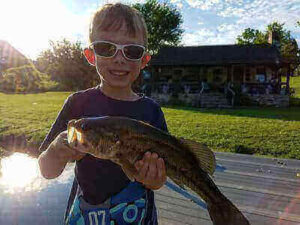
Largemouth Bass Fishing Tips
1. Adult largemouth bass prey on shad, yellow perch, shiners, sunfish, trout, walleye, and catfish.
2. You can find largemouth bass closer to the shore during spring, summer mornings, and winter afternoons.
3. Largemouth bass can be found around structures such as docks, fallen trees, and vegetation.
4. Largemouth bass is slower and lethargic in cold water and can be caught using a slower retrieve.
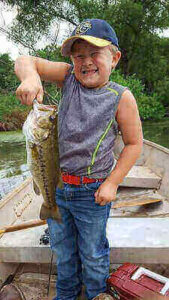
5. Largemouth bass spawns in spring to early summer.
6. Largemouth bass usually spawn in shallow water with direct sunlight that is within 10 feet of the shore usually with depths of 1 to 6 feet.
7. Largemouth bass are more active during spring and early summer when the water is warmer and they can be caught in shallow water.
8. The best time to fish for largemouth bass is early morning and evening.
9. Largemouth bass has good eyesight that they use to identify prey.
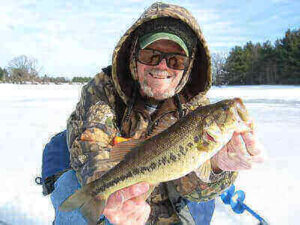
10. Largemouth bass see very well in low-light conditions than most of their prey.
11. You can use live bait and artificial lures to catch largemouth bass.
12. Mature bass move alone while the younger ones are found in schools.
13. Largemouth bass like slow-moving waters with soft bottoms.
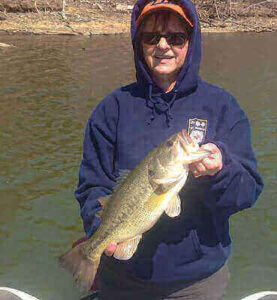
14. Largemouth bass like clear water.
15. Fly fishing, baitcasting, trolling, and bottom fishing are fishing methods used to catch largemouth bass.
16. Largemouth rarely goes after dead bait.
17. When you fish in a new area, river, lake, or shore, try to find out what the bass in that area are eating and match the hatch. Ask other anglers in the area or visit the local fishing tackle shop and talk with the people who work there.
18. If you are not getting any success with one bait, try another one. Vary the baits and lures until you get a fish.
19. One efficient fishing technique to use when fishing largemouth bass is the drop-shot.

20. On sunny days, largemouth bass will look for cover to provide to see their prey. Look for covers like docks, logs, and weeds.
21. On very hot days, search for largemouth bass in the deepest holes in the lakes. Find deep structures like rocks, bridge pilings, channels, or drop-offs.
22. Many anglers prefer baitcasting equipment over spinning ones because baitcasting gear is more versatile and allows for more dynamic fishing abilities.
23. On sunny days, look for frogs that swim from pad to pad as they attract the attention of largemouth bass.
24. Use lures if you will release the fish back into the water. Hook removal is easier with lures than with live bait.
25. Largemouth bass starts moving into shallow water during spring.
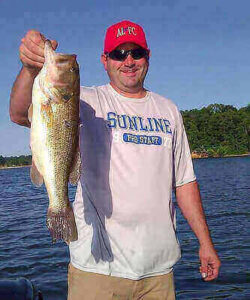
The Bottom Line
The largemouth bass is a popular gamefish for many anglers as they aggressively strike, fight hard, and can be found in many locations. In this article, we discuss fishing techniques, bass behaviors, fishing tips, and equipment to catch more largemouth bass.
If you also fish other types of fish like haddock, lingcod, white bass, black sea bass, spotted bass, and chain pickerel, you can read how to catch haddock, how to catch lingcod, how to catch white bass, how to catch black sea bass, how to catch spotted bass, how to catch yellow bass, and how to catch chain pickerel to catch more fish.
